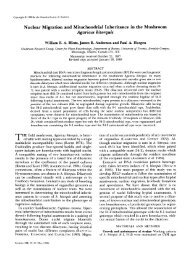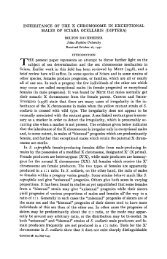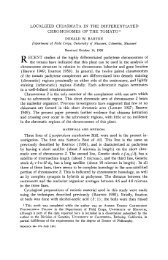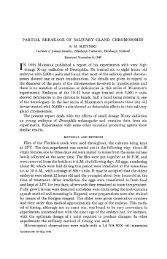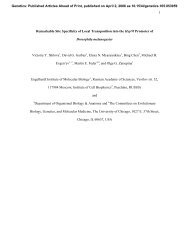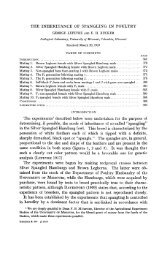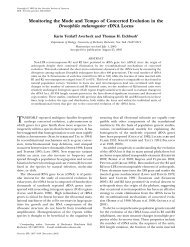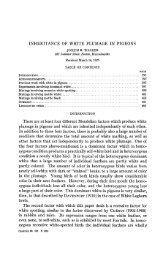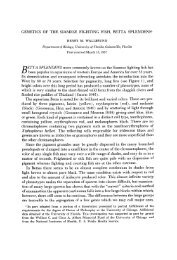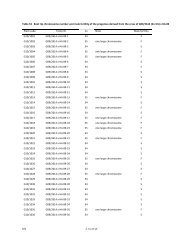abstracts of papers presented at the 1962 meetings - Genetics
abstracts of papers presented at the 1962 meetings - Genetics
abstracts of papers presented at the 1962 meetings - Genetics
You also want an ePaper? Increase the reach of your titles
YUMPU automatically turns print PDFs into web optimized ePapers that Google loves.
ABSTRACTS 961<br />
cessive gener<strong>at</strong>ions <strong>of</strong> single ascospore isol<strong>at</strong>ions were made in each line with concurrent selection<br />
maintained. Since each ascospore is usually heterokaryotic for m<strong>at</strong>ing type, <strong>the</strong> method provided<br />
as easy means <strong>of</strong> making repetitive intra-ascus crosses.-One <strong>of</strong> <strong>the</strong> low fertility lines showed<br />
in <strong>the</strong> fifth and successive gener<strong>at</strong>ions a very marked decrease in <strong>the</strong> number <strong>of</strong> ascospores<br />
ejected. After 12 gener<strong>at</strong>ions <strong>of</strong> inbreeding, <strong>the</strong> two m<strong>at</strong>ing types <strong>of</strong> this low yielding strain and<br />
those <strong>of</strong> a high yielding strain were isol<strong>at</strong>ed by conidial pl<strong>at</strong>ing.-Tetrad and backcross analyses<br />
were made on <strong>the</strong>se two high and two low yielding strains with yields being measured by<br />
spectrophotometric readings <strong>of</strong> ascospore suspensions. Strict quantit<strong>at</strong>ive inheritance was not<br />
found but r<strong>at</strong>her a locus segreg<strong>at</strong>ing independently <strong>of</strong> <strong>the</strong> m<strong>at</strong>ing type factors. This locus does<br />
not prevent production <strong>of</strong> viable progeny as do <strong>the</strong> d, E and I lethals <strong>of</strong> Dodge but instead lowers<br />
<strong>the</strong> yield, <strong>the</strong> few ascospores th<strong>at</strong> are ejected being capable <strong>of</strong> germin<strong>at</strong>ion. (Supported by Na-<br />
tional Science Found<strong>at</strong>ion Grant G-13267.)<br />
Hsu, K. S., Stanford University, Stanford, California: Genetic basis <strong>of</strong> drug-resistant mutants<br />
in Neurospora.-Strains resistant to acriflavine, actidione, and caffeine have been obtained which<br />
arose by mut<strong>at</strong>ion <strong>of</strong> chromosomal genes. These provide a useful new class <strong>of</strong> markers in Neuro-<br />
spora.-Among <strong>the</strong> acriflavine-resistant mutants, one allele has been recovered <strong>at</strong> <strong>the</strong> acr-I locus<br />
in <strong>the</strong> left arm <strong>of</strong> linkage group I. This confers resistance to 2 pg per ml <strong>of</strong> <strong>the</strong> dye. Mutants<br />
resistant to 10 pg and 50 pg per ml have been obtained <strong>at</strong> <strong>the</strong> acr-2 locus, which is <strong>the</strong> first<br />
marker to be loc<strong>at</strong>ed in <strong>the</strong> left arm <strong>of</strong> group 111. Actidione-resistant mutants have been assigned<br />
to two loci: act-I near al-2 in IR, and act-2 in VR. All are resistant to 10 pg per ml <strong>of</strong> <strong>the</strong> anti-<br />
biotic. Resistance to 0.25% caffeine is conferred by gene caf-1 in linkage group V.-With <strong>the</strong><br />
exception <strong>of</strong> two acriflavine-resistant mutants, which were picked up during serial subculture on<br />
acriflavine-containing minimal medium, all <strong>of</strong> <strong>the</strong> mutants were recovered by pl<strong>at</strong>ing conidia<br />
from conidi<strong>at</strong>ing colonial strains (cr cot, cr cot ylo, cr rg, or cr bal) on Vogel's minimal medium<br />
plus <strong>the</strong> drug, <strong>at</strong> concentr<strong>at</strong>ions such th<strong>at</strong> no growth was observable when 106 to 10' conidia<br />
from <strong>the</strong> sensitive strain were pl<strong>at</strong>ed. UV-irradi<strong>at</strong>ion giving 50-75% killing was applied in some<br />
cases. Scoring for resistant us. sensitive is clear-cut for all <strong>of</strong> <strong>the</strong> three c<strong>at</strong>egories <strong>of</strong> mutants.<br />
(Supported by Public Health Service research training grant 26-158.)<br />
HUANG, P. C., S. EMERSON, and MARY R. EMERSON, California Institute <strong>of</strong> Technology, Pasadena,<br />
Calif .: Syn<strong>the</strong>sis <strong>of</strong> heterokaryons involving a plasmodioid (slime) variant <strong>of</strong> Neurospora<br />
crassa, and isol<strong>at</strong>ion <strong>of</strong> <strong>the</strong>ir nuclear components.-The UV-induced plasmodioid variant, slime,<br />
<strong>of</strong> N. crassa is characterized by a Physarum-like morphology and is deficient in <strong>the</strong> cell wall.<br />
Its presumptive parent, Stanford 1207-1A, had five markers in <strong>the</strong> m<strong>at</strong>ing type chromosome:<br />
A, arg-2, cr, aur and os. The slime isol<strong>at</strong>e retained <strong>the</strong> specific requirement for arginine and,<br />
though outcrosses to wild type were highly infertile, <strong>the</strong> five marker genes <strong>of</strong> 1207-1A segreg<strong>at</strong>ed<br />
in <strong>the</strong> expected combin<strong>at</strong>ions and proportions. Three genes, os and two new mutants, are<br />
necessary but not in <strong>the</strong>mselves sufficient for <strong>the</strong> production <strong>of</strong> <strong>the</strong> slime phenotype. Heterokaryons<br />
were used in <strong>the</strong> present study to detect a possible cytoplasmic factor. A heterokaryon<br />
was established between slime and Stanford strain 1413-2A carrying A, lys-3, nic-I, al-2 and OS<br />
in <strong>the</strong> m<strong>at</strong>ing type chromosome. Under <strong>the</strong>se heterokaryotic conditions <strong>the</strong> wild-type alleles <strong>of</strong><br />
al-2 and aur complement in <strong>the</strong> production <strong>of</strong> carotenoid pigments and those <strong>of</strong> lys-3 and nic-1<br />
with arg-2 for growth. The inhibition <strong>of</strong> lys-3 mutants by arginine and <strong>of</strong> arg-I mutants by<br />
lysine was made use <strong>of</strong> in observ<strong>at</strong>ions on <strong>the</strong> heterokaryons and <strong>the</strong>ir isol<strong>at</strong>es under a variety <strong>of</strong><br />
conditions. The results support <strong>the</strong> inference th<strong>at</strong> <strong>the</strong> slime character is determined solely by <strong>the</strong><br />
nucleus. Special techniques will be discussed and observ<strong>at</strong>ions will be exemplified with slides.<br />
HUBBY,<br />
J. L., University <strong>of</strong> Chicago, Chicago, Illinois: Protein differences in DrosophiZa.-<br />
Analyses <strong>of</strong> ammonium sulf<strong>at</strong>e fractions <strong>of</strong> <strong>the</strong> soluble protein in Drosophila have been made<br />
utilizing acrylamide gels as a supporting medium for zone electrophoresis. Several differences in<br />
migr<strong>at</strong>ory r<strong>at</strong>es <strong>of</strong> proteins in strains <strong>of</strong> Drosophila melanogaster carrying genetic markers have





